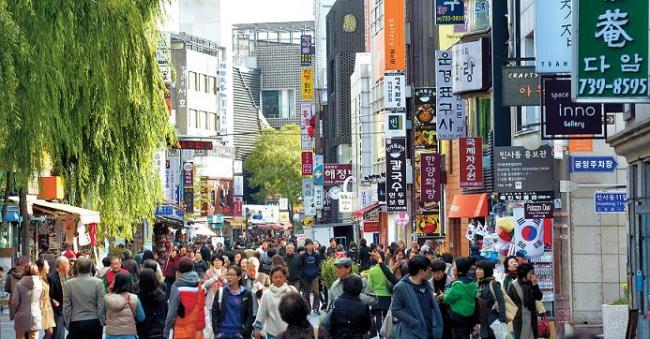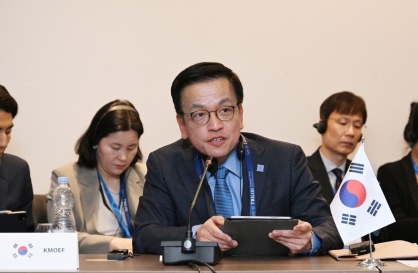Insa-dong loses cultural luster amid rising prices
By Korea HeraldPublished : Nov. 27, 2012 - 19:02
It has been 10 years since Insa-dong was designated a culture district, but criticism is growing that it has lost its unique character due to overcommercialization.
The area, famous for its traditional aesthetic, antique shops and art galleries, was the country’s first designated culture district in 2002. Daehangno, Incheon port and Paju Heiri are the other designated cultural districts in Korea.
Created in 2000, the culture district designation is part of the Culture and Arts Promotion Act of the Ministry of Culture, Sports and Tourism in order to promote and expand culture and arts in significant areas.
Although culture districts are eligible for benefits such as tax breaks as well as eased construction standards, many criticize Insa-dong for becoming overly commercialized over the past decade.
Along the main Insa-dong road, many stores that sell pottery and old paintings are now in-name only, and display cheap, foreign-made souvenirs and K-pop idol posters in front of their stands while their original products are stashed in a far corner or nonexistent.
Further down the street are makeup shops, convenience stores and chain restaurants that can easily be found in other parts of Seoul. The alleys off the main strip host mostly Korean restaurants, with a few antique stores surviving.
Many store owners in Insa-dong refused to speak for an interview about their situation.
Lee Jong-un, the owner of antique bookstore Tongmunkwan, explained that most stores stopped selling traditional items since rent started rising in the ’90s, when Insa-dong began to attract more tourists.
“People are selling cheap souvenirs as a desperate attempt to manage the property rent,” said Lee. “If the rent was cheap, there would be no reason to do this.”
Lee said the only reason that he was able to keep his family bookstore, which opened in 1934, was that they owned their own building, unlike most shop owners who were paying rent to landlords.
“The place used to be filled with antique bookstores and shops in the ‘70s and ’80s,” Lee said. “I’m sorry to say it, but most first-floor shops around here don’t sell traditional culture anymore.”
The area, famous for its traditional aesthetic, antique shops and art galleries, was the country’s first designated culture district in 2002. Daehangno, Incheon port and Paju Heiri are the other designated cultural districts in Korea.
Created in 2000, the culture district designation is part of the Culture and Arts Promotion Act of the Ministry of Culture, Sports and Tourism in order to promote and expand culture and arts in significant areas.
Although culture districts are eligible for benefits such as tax breaks as well as eased construction standards, many criticize Insa-dong for becoming overly commercialized over the past decade.
Along the main Insa-dong road, many stores that sell pottery and old paintings are now in-name only, and display cheap, foreign-made souvenirs and K-pop idol posters in front of their stands while their original products are stashed in a far corner or nonexistent.
Further down the street are makeup shops, convenience stores and chain restaurants that can easily be found in other parts of Seoul. The alleys off the main strip host mostly Korean restaurants, with a few antique stores surviving.
Many store owners in Insa-dong refused to speak for an interview about their situation.
Lee Jong-un, the owner of antique bookstore Tongmunkwan, explained that most stores stopped selling traditional items since rent started rising in the ’90s, when Insa-dong began to attract more tourists.
“People are selling cheap souvenirs as a desperate attempt to manage the property rent,” said Lee. “If the rent was cheap, there would be no reason to do this.”
Lee said the only reason that he was able to keep his family bookstore, which opened in 1934, was that they owned their own building, unlike most shop owners who were paying rent to landlords.
“The place used to be filled with antique bookstores and shops in the ‘70s and ’80s,” Lee said. “I’m sorry to say it, but most first-floor shops around here don’t sell traditional culture anymore.”

Kim Yu-cheol, manager for Insa-dong at the Jongno-gu Office, echoed Lee’s statements that rising rent drove out traditional craft in Insa-dong.
“The landlords raised the rent price according to the market as more people visited Insa-dong, so traditional sellers could no longer pay rent or support themselves with traditional culture,” he said.
Despite the situation, Lee and Kim agreed that the government couldn’t force landlords to adjust rent prices for the sake of preserving culture.
Many art galleries and antique shop owners have allegedly moved to Samcheong-dong or parts of Gangnam, but Lee added that their prospects do not look bright.
“Even those places are turning into caf streets. The government won’t leave it alone if something is about to thrive,” he said.
The Insa Traditional Culture Preservation Committee, a civic organization that records statistics on Insa-dong, speculated that there were around 200 art galleries left, but many of them are in name only and sell cheap souvenirs to tourists.
Kim said both Jongno-gu and Seoul City had been trying to minimize the damage as much as they could, but were limited in supporting Insa-dong due to budget constraints.
“The central government should provide more support, but the Ministry of Culture, Sports and Tourism, who has authority over cultural districts, barely provided funding for the past ten years,” he said.
Kim said Jongno-gu currently provides a 50 percent reduction in property tax to cultural facilities for five years and reduced building costs for landlords.
However, he pointed out the benefits are not effective in the long run since a five-year tax reduction lacks continuity, and because over 90 percent of businesses in Insa-dong are tenants, the store owners themselves receive no benefits.
“We have proposed reducing income and additional tax for the business owners instead, but the current government seems reluctant,” Kim said.
He believed that the biggest factor causing Insa-dong to lose much of its culture was the general lack of action toward preserving tradition.
“As a culture district, it had regulations regarding what is allowed or not, but this was not held up because there were no real penalization for violations,” he said.
“Seoul City and the Ministry of Culture, Sports and Tourism were negligent with restrictions.”
In response to the concerns and criticism, Kim said Seoul City was planning revised legislation that would improve the situation.
Among the proposed changes is the “traditional culture certificate,” where authentic traditional stores would be given a certificate that tourists can identify.
“One of the problems is that tourists want to buy traditional products, but have difficulty because of the cheap souvenirs,” Kim said.
Because banning cheap souvenirs altogether is against trade laws, they decided the best alternative was to promote the authentic products so that tradition does not die out.
Other changes planned in the revised legislation include changing the names of stores that no longer sell products they claim, providing more direct support to the businesses and including makeup shops and massage parlors on the list of businesses prohibited from entering Insa-dong, with a maximum penalty of 10 million won ($9,200) when violated.
“What is hopeful is that several congressmen showed much interest in Insa-dong, and we hope the revised legislation can gain momentum with their support,” Kim said.
However, Lee said, despite media focus on the loss of culture in Insa-dong, nothing has changed.
“They’re repeating problems that won’t be solved. It’s the same old story for years,” he said. “It’s difficult to manage a location once it has turned into a tourist spot. Even tourist spots overseas are filled with souvenir shops. It’s unrealistic to bring change.”
“What is clear is that you can’t go back to how it used to be,” he said
Kim acknowledged that multiple factors caused Insa-dong to deteriorate, but emphasized that Jongno-gu had not been idle all this time.
“We are trying to fix what has gone wrong under the new Jongno-gu office director, though it is not enough with willpower alone,” he said.
By Sang Youn-joo (sangyj@heraldcorp.com)
-
Articles by Korea Herald






![[Weekender] Korean psyche untangled: Musok](http://res.heraldm.com/phpwas/restmb_idxmake.php?idx=644&simg=/content/image/2024/05/02/20240502050841_0.jpg&u=)


![[Herald Interview] ‘Time to Be Strong’ follows retired K-pop idols’ self-discovery](http://res.heraldm.com/phpwas/restmb_idxmake.php?idx=644&simg=/content/image/2024/05/03/20240503050550_0.jpg&u=)
![[Eye Interview] 'If you live to 100, you might as well be happy,' says 88-year-old bestselling essayist](http://res.heraldm.com/phpwas/restmb_idxmake.php?idx=644&simg=/content/image/2024/05/03/20240503050674_0.jpg&u=)







![[Herald Interview] Director of 'Goodbye Earth' aimed to ask how we would face apocalypse](http://res.heraldm.com/phpwas/restmb_idxmake.php?idx=652&simg=/content/image/2024/05/03/20240503050732_0.jpg&u=)
